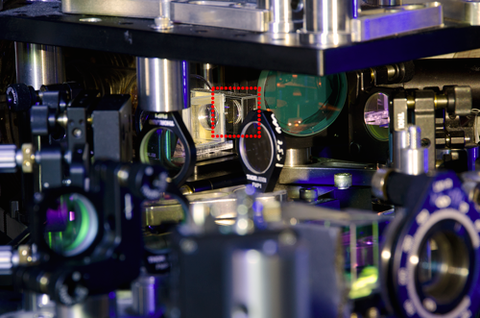
A close-up photo of the center of the experimental set-up. The small transparent chamber that holds the ultracold rubidium atoms is surrounded by a dotted line.
Since their discovery in 1986, high-temperature (high-Tc) superconductors have been the subject of intense interest to researchers. But the mechanism behind the superconducting phase transition in these materials remains poorly understood and extremely difficult to study directly.
Now researchers from PML and the Joint Quantum Institute, a research partnership of NIST and the University of Maryland, have published the results of a novel quantum simulation they devised to examine the effect of introducing controllable amounts of disorder into a system in which atoms serve as the functional equivalent of electrons moving through a high-Tc superconductor.
They report direct observation of the mechanism predicted for the disorder-driven superconductor-to-insulator transition in certain two-dimensional systems, an insight immediately relevant to understanding superconducting thin films and high- Tc materials.
"High-temperature copper-oxide superconductors are made of stacks of weakly-coupled planes of atoms with a certain amount of disorder or impurities in the arrangement of the atoms in the material. The physics of these disordered 2D systems seems to play a large role in determining their material properties," says Matthew Beeler, first author of the recent paper, "and we wanted to explore that connection. In our experiment, we model the planes of the high-Tc material with two parallel surfboard-shaped atomic samples of a well-controlled ultracold gas."
The quasi-2D system is created using a 3D Bose-Einstein condensate (BEC) of 87Rb atoms confined in a cross-beam optical dipole trap. Then a shallow-angle optical lattice divides the BEC into two uncoupled, quasi-2D, planar "surfboard" samples.
In a BEC, all the atoms are coherent – that is, in the same quantum state. To introduce disorder into the two nearly identical sample sections, the researchers use an optical speckle beam which causes the atoms to be displaced from higher-intensity regions. The amount of disorder is proportional to the intensity of the beam. Temperature is controlled by adjusting the phase-space density of the BEC (and hence of the two samples) before adding disorder.
After adjusting temperature and applying a specific amount of disorder, the confinement fields and the optical speckle beam are rapidly shut off. The two quasi-2D samples then expand into one another, creating a single cloud.
As the expanding planes overlap, their atoms form an interference fringe pattern that can be observed with absorption imaging. The nature of that pattern is an indicator of the quantum state of the atoms -- specifically their phase coherence. If the atoms in both samples were completely Bose-condensed, with high phase coherence, then the interference fringes would be sharply defined with high contrast. Conversely, as disorder increases, the phase coherence of the atoms decreases and the patterns grow more diffuse and noisy.
At low disorder levels, the fraction of phase-coherent atoms correlates with the visibility of the interference pattern. But as disorder strength increases, the coherent atom fraction does not change commensurately.
One picture of superconductivity is that it is a superfluid of Cooper pairs -- two electrons that are bound together in a way that allows them to interact with oscillations in the surrounding lattice and travel without resistance. Superfluids have a mathematical definition that assigns two numbers to them, each representing a physical property of the system: amplitude (related to density) and phase (related to motion). The primary mechanism that destroys superconductivity is that the Cooper pairs of electrons fall apart into their constituent particles, effectively driving the superfluid amplitude to 0. However, it has been shown that these pairs can survive even when a superconductor is not superconducting, which is very surprising. One possible way that these pairs can exist but not superconduct is if the global phase of the superfluid becomes disordered. The JQI-PML team's measurement shows that laser speckle disorder has exactly this effect on the global phase of our system of 87Rb bosons, while not having nearly as large an effect on anything else that we can measure.
"Our results," says Beeler of PML's Laser Cooling and Trapping Group, "show that disorder generically drives phase fluctuations in quasi-2D systems. According to some theoretical models, these phase fluctuations are thought to be a mechanism behind the superconducting phase transition in high-temperature superconductors."
"Disorder figures in about half of all condensed matter physics," says Steve Rolston, co-director of the JQI and professor of physics at the University of Maryland. "What we're doing is mimicking the movement of electrons in three-dimensional solids using cold atoms in a two-dimensional gas. Since there don't seem to be any theoretical predictions to help us understand what we're seeing, we've moved into new experimental territory."
Additional information about the experiment appears in a video abstract posted on the website of the New Journal of Physics, and an expanded description of the work is available on the JQI website.
-- written by Delilah Gates

